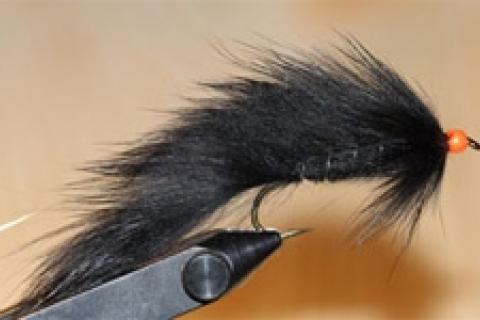
From Alaska to Arkansas, the Egg Sucking Leech without doubt is one of the top producing streamer flies to ever come out of a vise. As good as the traditional Wooly Bugger has been to fly anglers the Egg Sucking Leech is even better. The main reason for this patterns great success is its ability to be adapted to catch virtually any freshwater fish that exists. From trout to salmon and pike, the Egg Sucking Rabbit Strip Leech can just about do it all.
Just like other version of the bugger family, this fly was originally tied with black rabbit fur strips. More recently the Egg Sucking Leech has spawned an almost limitless amount of color combinations. Purple or natural rabbit fur variations have proven to be some of the more successful color combinations. This pattern is must have for any fly angler looking to fish spring runs of trout and salmon.
How to Fish It
Fishing the Egg Sucking Leech is relatively simple. If you are going to be fishing winter months or early season spring conditions with very cold water, cast this pattern to your target and let it dead drift drag-free down the river. Fish holding in cold temperatures become very lackadaisical and will not aggressively chase down your fly.
Using a slow delicate presentation with the Egg will help keep your fly in the strike zone longer providing you with a better chance of hooking into quality fish. In the spring and summer as the water temperatures gradually increase, fish will become more active and predacious. Cast your fly upstream of your desired target, let it sink for a few seconds and then give it three to four quick strips to get your retrieve started. Continue the fly working back to you by imparting short strips of line with intermittent pauses. This technique will get aggressive fish to chase and insatiably strike your fly.
Materials List
| Hook | Streamer Fly Hook Size 4 |
| Thread | Black/Red Uni Thread 8/0 |
| Head | Orange Bead |
| Tail | Black Rabbit Fur Strip |
| Body | Black Rabbit Dubbing |
| Rib | Fine Silver Wire |
| Legs | Pearl Flashabou |
| Collar | Black Rabbit Fur Spun |
| Weight | Lead Free Weight |
Step-By-Step Tying Instructions
|
Step 1 Start this fly by sliding the colored bead on the hook shank small hole first and pushing it up to the hook eye. Place your hook into your vice and secure it into place tightly. |
|
|
Step 2 Starting behind the bead wrap a small section of lead free weight onto the hook shank and wrap it down the hook until you reach the 1/2 way mark on the shank. |
|
|
Step 3 Attach the black tying thread onto the hook just behind the bead and make a few wraps to keep the lead free weight in place securely. Cut six 3 inch strips of pearl flashabou and tie them down to the top of the hook shank extending off the back of the fly. |
|
|
Step 4 Cut a three inch section of copper wire and tie it onto the hook shank at the 1/2 way point. Wrap this copper wire with the black thread down the hook shank until you reach the point above the barb. |
|
|
Step 5 Select a three inch section of Black Rabbit Fur Strip and tie the last one inch down at the point above the barb. Be sure to sweep the rabbit fur fibers forward while you are tying in this material. |
|
|
Step 6 Dub the thread with the black rabbit dubbing and create a tapered body towards the back of the bead. It is going to take some time to build a nice thick firm body for the fly. Dub it one layer at a time until you have the thickness you are looking for. |
|
|
Step 7 Pull the rabbit strip over the top of the body you just dubbed and tie it down directly behind the bead. |
|
|
Step 8 Counter wrap the silver wire up the body of the fly in the opposite direction that you dubbed the body. Take care in working the wire through the rabbit strip so that you do not bind down to much of the fur fibers. It should take 5-6 wraps to get to the front of the fly. |
|
|
Step 9 Create a dubbing loop with your tying thread and place about inch of rabbit strip fur into the loop. Spin the loop until a nice bushy fur hackle is created then wind this hackle around the hook behind the bead. As you wrap this fur hackle make sure to keep sweeping the fibers backward so that you do not unintentionally tie any fibers down. Make three or four wraps of thread back onto the now formed hackle collar to create swept look to the fly and then whip and cement the thread. |
- 11893 views

